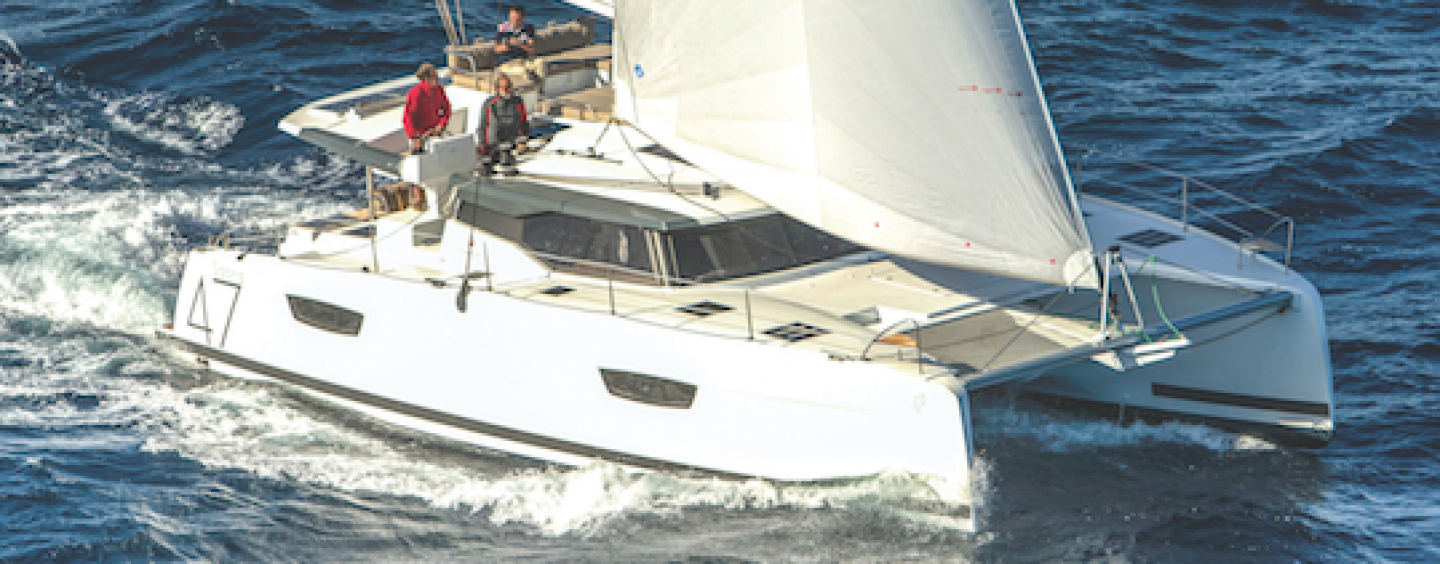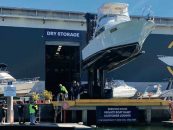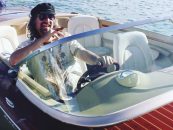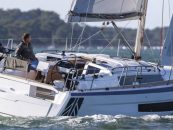Climbing over to the guest accommodation in the starboard hull brings you into an equally comfortable area with spacious semi-island bed and ensuite aft. Forward is an athwartships island bed with corridor bathroom. The large cupboard in the corridor can also house the optional washer-dryer – which runs from the 11kw Onan generator. Under-bed storage is another good feature in all cabins. Beyond this is a crew cabin in this port bow area that comes with a manual toilet and single bunk.
WALKING SPACE
Flat topsides are a major attraction for cruising cat buyers, a fact that Fountaine Pajot is acutely aware of, which is why the Saona has wide sidedecks with flush hatches, and a foredeck for partying on. A smaller trampoline area in favour of larger nacelle creates space for three sunpads but the practicalities are not neglected. A deep central locker houses a vertical Lewmar windlass/capstan which has a short run to the nacelle front where the anchor sits – so no rode to endanger children or unwary guests. A second roller is available for another more-ground tackle as well while the fibreglass bowsprit proved long enough to give good separation between the Code 0 and the forestay. Sizeable cleats are all around, including midships were the other good features on the Saona. Looking aft, the hydraulic teak clad swim platform is a 24,000 Euro option worth having as it doubles as a dinghy bench.
Looking at the rig, our review boat – hull one – came with a carbon mast and versatile sail plan on the cabin- mounted spars. A carbon Maxam mast (from Poland) was attached to an alloy Z Spars boom with guttering and lazy jacks for gathering the incidences mainsail. The sail was panelled using Hydronet sailcloth – a tightly woven polyester mixed with dyneema – which allows both easy sail handling with longevity and minimum stretch sailcloth. “You save about 15% weight with the carbon mast, which adds stiffness and reduces pitching,” FP director Yves de Kerangat told me. Single wire shrouds held up the rig, with large chain plates to spread the load of the squared top mainsail.
RACOPEAU-DESIGNED HULL
Improving performance is an ongoing facet even for sedate cruising catamarans, so the company has collaborated with the iconic, the Berret-Racoupeau house, to optimise the Saona. The more curvaceous topsides are matched by a similarly shaped nacelle and inner gunwhales to reduce wave drag. Hull and deck construction is by infusion – to optimise the fibre/resin ratio that impregnates the foam core while the saloon roof is injection-moulded. Underneath, moulded mini keels give directional stability and modestly sized twin rudders control the Saona. The volume in the aft of the hulls is apparent when I open an engine hatch, which showed the 50 HP four-cylinder Volvo saildrive to be rather dwarfed by its surroundings, leaving plenty of space in the port bay for the Onan generator and filters. Also, quick access is available here for the steering crossbar and rudder stocks.
MEDITERRANEAN SAIL
The Med is typically a hard task master for sailing yachts, as it either blows too much or too little, and our sail was the latter with 7.0 knots gently caressing the smooth seas. To cope with these conditions and minimise engine hours, a wide sail plan is required. So our Saona 47 came with a large Code 0 sheathed inside a snuffer for quick deployment and dousing. Once we had hoisted the Code 0 on its furling line – the halyard is at the mast base – the sock was peeled back to allow the sail to fill while on the helm. I eased the catamaran off the wind to about 160 degrees, pushing our speed to 10 knots.
The elevated starboard helm gave me clear views of main, and the Code 0, while just in front of me, the crew trimmed the sheets. Being separate from the binnacle prevents the steerer from trimming the sheets, but this layout does allow plenty of room for crew to do their job. So when it came to gybing the Code 0, I concentrated on turning the fairly large steel steering wheel while my crewmate trimmed and a third person walked the clew around the forestay as we changed heading. On port, tack trimming was done from a remote winch near the port quarter (while starboard was managed from the coachroof bank of winches). Wanting to sail nearer the wind, the snuffer sock was easily pulled down over the Code 0 and the long sausage of sail dropped on the foredeck, while my crewmate unfurled the genoa, which allowed me to point the cat at 50 degrees apparent, with our speed slowing to 4 knots.
Short-handed in these light conditions, the engines would likely be spun up so I did so, reaching a top speed of 8.8 knots with the Volvo 50HP spinning at 2,000 RPM, while dropping the revs to 2,200 still gave a nippy cruising speed of 7.9 knots (but no fuel burn figures were shown). Our Med afternoon showed the Saona 47 to be a very capable cruising catamaran, reflecting Fountaine Pajot’s vast experience in building comfortable and seaworthy boats.
Published in the Jan-Mar 2020 edition.






























